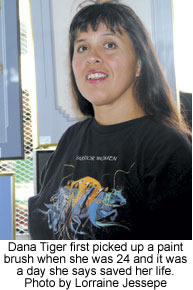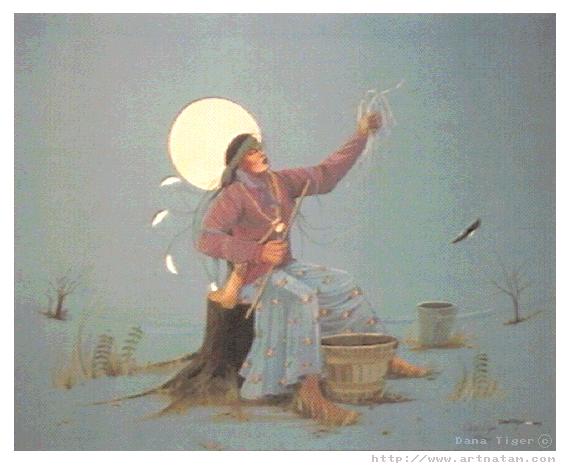 |
Canku Ota
|
 |
|
(Many Paths)
|
||
|
An Online Newsletter
Celebrating Native America
|
||
|
December 1, 2009 - Volume
7 Number 12
|
||
|
|
||
|
Dana Tiger Answered
The Voice Inside
|
||
|
by Lorraine Jessepe
- Indian Country Today correspondent
|
||
|
"I remember the very day it happened. The voice inside me said ‘pick up the paint brush and do what you know.'" That day, Tiger made a commitment to paint everyday for a year. It was that day that Tiger began her career as a painter; and it was the day that saved her life. It's Monday morning, and the artist/activist is home in her Muskogee art gallery after attending another weekend art show. Her schedule takes her to at least two shows a month. Most, recently, she attended the Haskell Indian Art Market, held each September on the grounds of Haskell Indian Nations University in Lawrence, Kan. There, she also had the opportunity to interact with Native youth. "It's nice to see the young artists coming up." Tiger
says it's the family atmosphere at Haskell that has brought
her back to the event the past 20 years. Dana and the Tiger family have a distinguished place in the Native American art world. Dana's father, Jerome Tiger, was a charismatic, nationally acclaimed artist. A street fighter and high school dropout with no formal art training, Tiger is credited with revolutionizing American Indian art. The "Tiger style" has been described as a combination of spiritual vision, humane understanding and technical virtuosity. "Daddy was a natural genius. He was given a gift," Tiger said. "He just lived with gusto. And then he left." Jerome died in 1967 from an accidental gunshot wound; Dana was 5. She has gone on to establish herself as one of America's leading women artists. Her one-woman art shows sell out. Of Creek, Seminole and Cherokee descent, Dana is best known for her paintings depicting the strength and resilience of contemporary Native women. "I try to use tradition to make contemporary art. I think about that while I'm painting." Tiger frequently incorporates the moon in her paintings, saying it symbolizes the circle of life. "It's empowering and strengthening to me." Recently, Tiger took first place at the Cherokee National Holiday Art Show for her painting, "We All Belong." Ironically, the inspiring themes in Tiger's work stem from some negative experiences she had as a school girl. "The teachers didn't expect much out of me because I was a Native female student. During this time, she also became aware of the negative words used to describe women. Tiger developed a false view of herself, "Our naturalness was told it was ugly and bad."
Over time, Tiger's life headed in a downward spiral. "I thought drinking and partying was the fun thing to do; I didn't respect myself." At 24, Tiger had talent, but said she failed to nurture it. "The basis of everything is the love that you give it. If you nurture it, it will pay off." And so Tiger painted – everyday for a year. "I still feel he spoke to me," meaning her father's spirit. She also quit drinking, watched what she ate and eliminated sugar – not an easy task. "Life is a job," she said. "Life is work." In 1990, Tiger suffered a devastating loss when her brother, Chris, also an artist, was murdered at age 22. Then, in 1992, her only surviving sibling, Lisa, tested positive for HIV, the virus that causes AIDS. Tiger has lived through days when she dreaded seeing the sun rise and the thought of getting out of bed to face the world as though everything were OK. "Everything was just like broken glass that I'd been walking on. I just kept painting." Through her art, Tiger has come full circle, taking the affliction from her life experiences and turning it into something empowering. "I hope to give inspiration that there's always a better day. My art symbolizes that hope and potential." In 1999, Tiger was diagnosed with Parkinson's disease, a degenerative disorder of the central nervous system that impairs motor skills and speech. She's not wasting any time feeling sorry for herself. "I can paint anytime I want to. That's my power. That's my gift. If it (Parkinson's) takes my hands away, then I'll think of another way." Tiger and her husband, Donnie Blair, have a daughter, Christie, and a son, Lisan. "I do pretty good," Tiger said. "I think I've been blessed. I feel better than I've ever felt. I've got goals and plans, and I love them." To honor the legacy of her family and her people, Tiger founded the Legacy Cultural Learning Community in 2002, a nonprofit devoted to bringing the arts to Native youth. "There's so much you can learn from people who created beauty. We're living in honor of them." Tiger spoke about one of her most well-known works, "From the Four Directions," a painting in which she offers not just beauty, but also, a way to live. "Pay attention to the Four Directions," Tiger said. "Nurture, plant, renew, give thanks, pray. "Then go out and kick ass," she said, laughing. Tiger was inducted into the Oklahoma Women's Hall of Fame in 2001 for advocating through art on behalf of women, children and Native Americans.
|
|
|
||
|
|
||
| Canku Ota is a free Newsletter celebrating Native America, its traditions and accomplishments . We do not provide subscriber or visitor names to anyone. Some articles presented in Canku Ota may contain copyright material. We have received appropriate permissions for republishing any articles. Material appearing here is distributed without profit or monetary gain to those who have expressed an interest. This is in accordance with Title 17 U.S.C. Section 107. | ||
|
Canku Ota is a copyright ©
2000, 2001, 2002, 2003, 2004, 2005, 2006, 2007, 2008, 2009 of Vicki
Barry and Paul Barry.
|
||
 |
 |
|
|
The "Canku
Ota - A Newsletter Celebrating Native America" web site and
its design is the
|
||
|
Copyright ©
1999, 2000, 2001, 2002, 2003, 2004, 2005,
2006, 2007, 2008, 2009 of Paul
C. Barry.
|
||
|
All Rights Reserved.
|
||
 MUSKOGEE,
Okla. – Dana Tiger was 24 when she first picked up a paint
brush.
MUSKOGEE,
Okla. – Dana Tiger was 24 when she first picked up a paint
brush.
